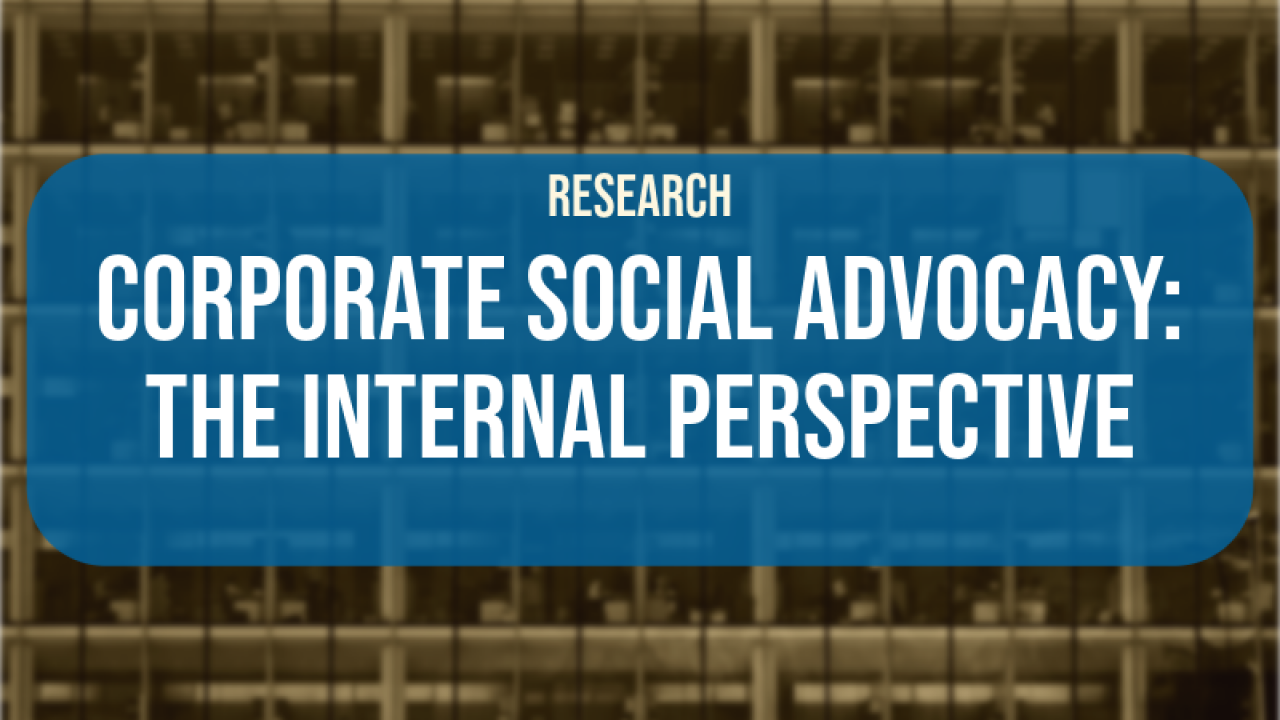July 15, 2024
Understanding CSA from the perspectives of PR professionals and employees

By Hyejoon Rim, Chinese University of Hong Kong; Moonhee Cho, University of Tennessee; and Katie Haejung Kim, University of Tennessee at Knoxville
While increasing scholarly attention has begun to explore corporate social advocacy (CSA) and its consequences from the external publics’ (e.g., consumers) perspectives, there is a very limited approach in the way CSA is being discussed from the perspective of the organization itself and among its internal stakeholders.
To fill the research gap, this study adopted a multi-method approach, exploring CSR from the perspective of corporate communication/public relations professionals and employees of large U.S. corporations.
Study 1: Interviews with communication professionals from U.S. large corporations
The first study employed semi-structured online interviews with 20 public relations, corporate communication, and CSR managers of large U.S. corporations. The following are the main findings from the interviews:
► Reasons for action versus inaction
Prominent reasons for taking CSA include focusing on core stakeholders, aligning with corporate identity and culture, responding to CEO characteristics, peer pressure, seeking purpose and value, and relevance to business.
Reasons for inaction of CSA are related to risk mitigation, irrelevance to business, an apolitical company stance, respect for global cultural differences and religion, lacking resources, and avoiding public attention.
► Different views and expectations; a real challenge for corporate communications
There is no internal agreement on whether CSA is essential to business or risk to business. The majority of the interviewees shared their fear of getting in trouble, particularly for the fact that a statement on a controversial issue will never make everyone happy. Yet, some argue that it is necessary to advocate for issues that are important to the business or its missions, as failing to do so could result in losing the support of key stakeholders.
► Making substantial efforts in internally-focused practices than external practice
Many interviewees indicated that their organizations are choosing not to take public stances on particular issues, but are communicating internally about the topics that are important to employees.
► Conflicts and Resolutions
The interviews identified three types of conflicts in practicing CSA from the interviews: 1) between an organization and employees due to the expectation gap, 2) between employees (e.g., the generational gap between employees with regard to their expectations and preferences for CSA), and 3) between departments (e.g., the human resource department versus communication team, which often generate due to the conflict of interest)
Study 2: Interview and surveys with employees from U.S. large corporations
The study conducted preliminary interviews and a survey with both open-ended and closed-ended questions among employees from U.S. large corporations. These studies revealed the following results:
1. Employees generally perceive their companies take liberal stances on controversial issues, which include support for LGBTQ+ rights, gender equity, and same-sex marriage. Our survey also showed that the top three prominent CSA issues supported by their employers included Diversity and Inclusion (29.5%), Climate change (21.3%), LGBTQ+ (15%), and Race/ethnic inequality (12.5%).
2. Employees expect CSA communication to be internally-prioritized, transparent, and inclusive. They value the organizations’ efforts to prioritize the implementation of such issues internally even without active public-facing communications (i.e., internal prioritization).
3. Notably, our survey findings showed that employees generally provided positive evaluations on their employers’ efforts in CSA communications (i.e., open and mutual communication), and there were only little discrepancies between their expectations and the actual experiences. Furthermore, employees were more likely to perceive their employers as engaging in CSA primarily driven by intrinsic motivation rather than extrinsic motivation.
This is the first-ever study exploring perspectives from both communication professionals and employees concerning the emerging corporate trend of CSA. Our work illustrates several key characteristics of how CSA is understood and implemented within organizations. Recognizing the significance of CSA for their employees, professionals are increasingly prioritizing their internal publics in their CSA communication efforts.
Our survey reveals that employees highly value their organization’s communication efforts, feeling informed and involved in the CSA process. While CSA presents new challenges for professionals, it also presents opportunities to foster a sense of shared purpose among employees, building trust that ultimately contributes to employee retention and loyalty. By communicating perspectives on pertinent issues for employees and their communities, organizations can bolster their sense of unity and collective purpose.
